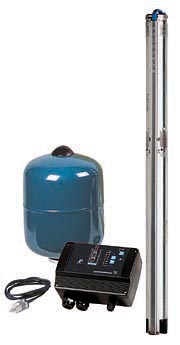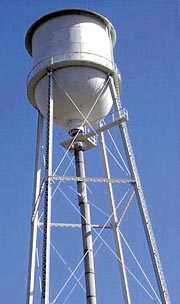
Replacing the piston pumps of yesteryear, submersible pumps have emerged as the most commonly used pumps in the water well industry, with submersible and jet pumps both having their own place. According to the American Ground Water Trust, approximately 60 percent of residential wells in the United States have electric submersible pumps; shallow well jet pumps are used in approximately 32 percent of U.S homes while eight percent of U.S. households use deep well jet pumps. Preferences on pump type have to do with a number of factors.
For larger applications such as industrial or municipal wells, water quality tests can help determine what type of pump and which material composition should be used. But in smaller domestic wells, where a water quality test would cost more than the pump itself, the size and depth of the well, the amount of water available and the price of the pump are the more likely determining factors.
What kind of pump is best for a residential system ultimately comes down to the well itself and user preference. “Just as with household electronics,” reveals Goulds Pumps' George Strally, “there is a system for everyone - jet pumps, standard submersibles or constant pressure submersible systems. Some consumers buy solely on price, some want the latest and greatest. People used to city water supplies who move to a home with a well favor the constant pressure systems. People who grew up with the pressure fluctuations of a pressure switch-controlled standard system seem satisfied with what they have.”
When it comes to the latest technologies in water pumping systems, stabilizing water pressure is of utmost concern, and variable-speed pump systems with electronic controls are considered the state-of-the-art today. Often called constant pressure systems because they do not exceed the 20-psi differential that's typically used with pressure switch and captive air tank systems, these systems offer stable pressure, varying only two to three psi in normal operation. According to Strally, “They are the closest thing in the pump industry to city-like water supply.”
Constant pressure systems use different approaches in their pump and motor set-up, but accomplish the same effect, Strally explains. For example, while some systems use 4-inch standard-speed, 3,450 rpm motors and standard matched pump ends (i.e. a 1 HP motor with a 1 HP water end); some utilize 3-inch diameter high-speed motors and 3-inch pumps; and others use 4-inch standard motors operating at up to 4,800 rpm with mismatched pump ends (i.e. a 11⁄2 HP motor with a 3⁄4 HP water end), ultimately, they all achieve the same end result.
The benefit of a constant pressure system is that, as the name indicates, it provides steady water pressure, especially when multiple applications are being used at the same time. Take, for instance, a 4-or 5-gallon-a-minute residential setting where someone's showering upstairs, laundry is running downstairs and outside someone is watering the lawn with a garden hose. The person in the shower, Stan Dodson of National Pump's Olive Branch, Miss.-branch, describes, will experience fluctuations if a conventional pump system is being used in such a situation. If the pressure switch is set at 30/50, the person using the shower at times will have 30 pounds of pressure coming out of the nozzle and at other times, 50 pounds of pressure. With a variable-speed pumping system, however, the individual showering would experience a constant water pressure.
An additional benefit is constant pressure systems can extend pump and motor life. Pumps and motors actually will last longer if turned on and run constantly, instead of starting and stopping repeatedly. Energy consumption can be more efficient, and in some cases, the size of the installation, in terms of the tank or pump, can be smaller than other units.
While the constant pressure technology has not reached the end user yet, there's a great deal of interest in these systems. The water well contractors and pump installers who are familiarizing themselves with constant pumping capability are seeing the results; according to Dodson, “the good contractors are definitely having good success at marketing these and selling them in the field.”
Another technological advancement is up-thrust protection in submersible pumps without constant pressure. An innovation engineered into the design of the pumps that have it, up-thrust protection guards against and reduces wear on the internal mechanisms and thereby extends use. When a pump turns on, it revs up, putting stress on the parts inside; as Don Coon, Hays Pumps, illustrates, “All the guts - the propellers and the diffusers - are going to be pushed up. If there's no protection for that pushing it up, it'll cause what they call scrubbing on the impellers and diffusers, and that will cause premature wear and breakage inside the pump.”
To combat premature wear-and-tear, devices are included to limit shaft movement inside the pump. In some pumps offering up-thrust protection, a setscrew is built-in at the top of the shaft, intended to prevent the shaft from being pushed up. Other pumps with an up-thrust protection feature use different safety mechanisms to inhibit movement. As Coon describes, “We provide two bearings inside our pump with a quantum. We have an upper and lower bearing on both ends of the shaft, with also an up-thrust washer at the base that limits the shaft movement so that shaft is going to be pushed up only so far and it will be stopped.”
So, whether inside the pump itself or integral to the system, protecting longevity is another focus for the pump industry's efforts in technological improvements. Alternative energy sources also have surfaced as an area of growth. Solar-powered submersibles are gaining somewhat in interest. Especially with energy prices on the rise, solar power is beginning to catch people's notice. A more expensive option at the moment, this developing technology still must catch up to more established counterparts, predominantly because until recently, the demand hasn't been there.
Going forward, what else can we expect for the residential pump market? Dodson offers his opinion: “At this point, I see the stainless [steel submersible] being the Cadillac of the industry for some great time to come.”

Expanding Markets
As municipal water systems expand and the water industry becomes increasingly smaller, many water well contractors are looking for ways to broaden the services they offer the consumer, and that can include providing pumping systems. Dan Mansfield, Wicor Industries, reports: “Everyone in this industry, because of consolidation, is having to look at diversification.” For the contractor looking to increase market offerings, pressure boosting is a quickly developing market, and becoming an all-around water professional is an increasingly attractive option. “As public water expands, their infrastructure really hasn't been updated to give the homeowners the kind of pressures or the volumes they demand, so pressure boosting is a growing market, as is water treatment,” Mansfield says.Likewise, Strally cites the same trend: “We see a huge growth potential in residential booster systems. Many municipal systems are taxed to the max, yet no one wants a huge water tower in their backyard and most municipalities don't have $4 million for a new water tower. The solution is to follow the European trend: The town gets the water to your doorstep; the household provides the pressure.”
Some contractors may be reluctant to step into the residential boosting market, especially if there's no water well on-site. Mansfield suggests that contractors also consider that the baby-boomer generation no longer subscribes to the DIY philosophy. “The trend that we see is that particular generation does not want to do things themselves. In fact, they're looking for it to be done for them,” he states. “They've either accomplished their financial growth or they don't want to spend their weekends figuring out an irrigation system or putting in a pressure tank; they want to pay the professional.”
Contractors sensitive to this trend and willing to diversify can take advantage of opportunities where homeowners are looking for water professionals to help them address water system solutions.
Expanding into the wastewater pump market is another area of potential growth, particularly in areas with limited ground water resources where water reclamation provides potable water supplies. Although it is being embraced by only a small number of water well contractors at this time, it too remains a possible area for diversification. ND
Report Abusive Comment